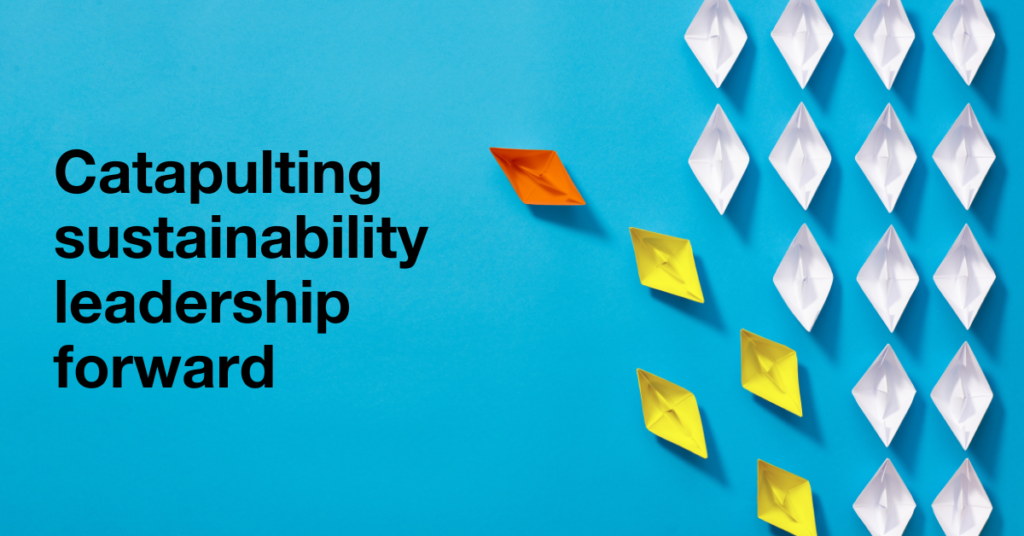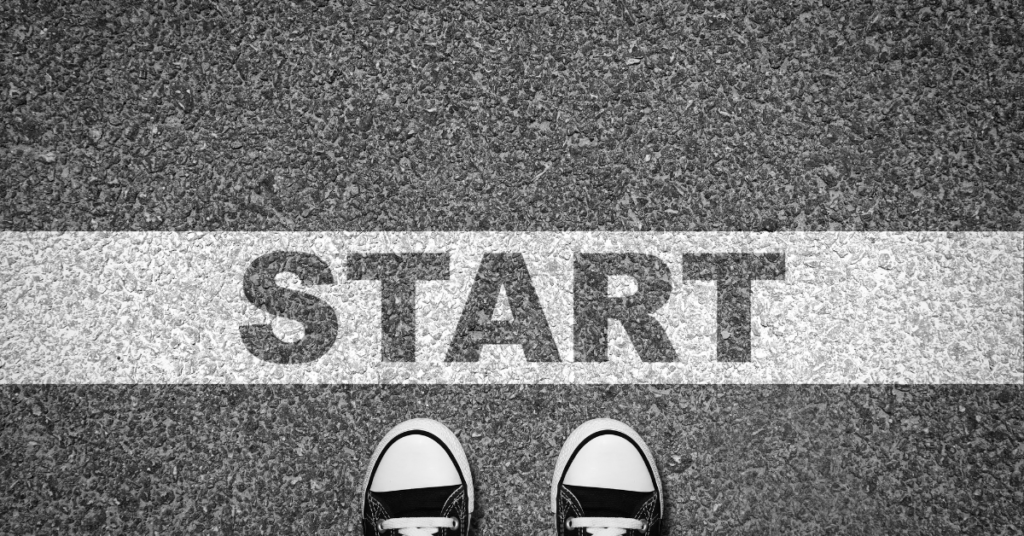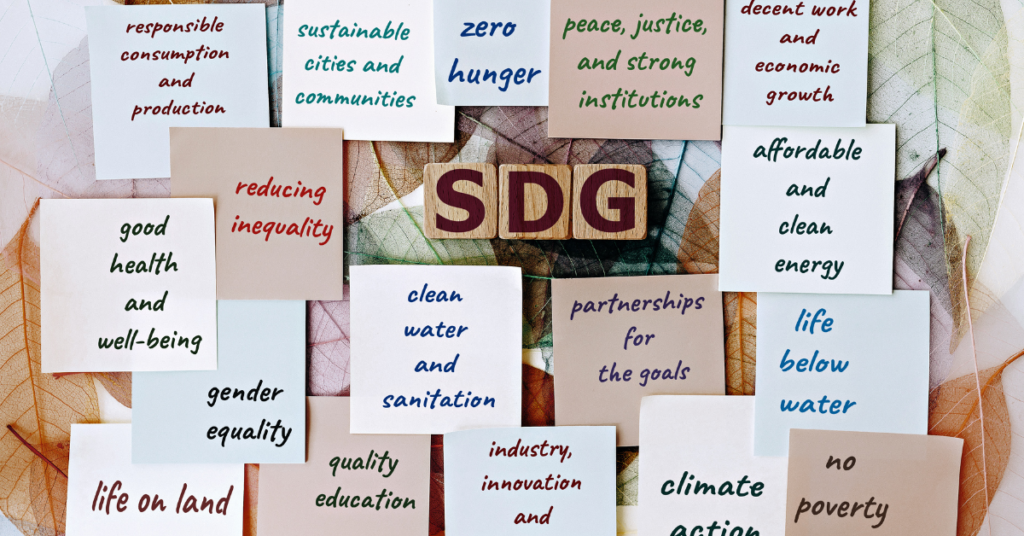Leadership is not a role title or something you’re ‘given’, it’s something you ‘do’ — you lead. And in the face of myriad social, environmental and economic issues, it seems that our world is calling out for a particular kind of leader right now, one with a specific skillset. What we need right now are sustainability leaders.
A ‘sustainability leader’ is someone who possesses a boundary-crossing and adaptable set of skills fit for navigating the complexities of the modern world. From being able to take a ‘systems approach’ to the ability to creatively problem solve, and from the skills to story weave and listen, to the capacity to hold and maintain high accountability spaces — a sustainability leader guides and influences others towards a shared vision for collective success, with a worldview that is enduringly ‘ecocentric’ not egocentric.
Against this backdrop, we caught up with leadership expert and co-founder of B Corp Catapult, Andrea Thompson, to unpack the evolution of sustainability leadership in our region and get her insights as to how emerging sustainability leaders can drive meaningful impact agendas within their organisations and industries.

Image by ilkercelik from Getty Images
B Lab: Thanks for taking the time to chat with us Andrea. Your organisation, Catapult, has exemplified the kind of leadership that drives the B Corp movement forward. But what do you see as being the specific hallmarks of a ‘sustainability leader’?
Andrea: Sustainability challenges are complex and require new leadership capabilities. A ‘sustainability leader’ is one who has the capabilities to:
- See the bigger picture and think ‘future-back’ and ‘outside-in’;
- Diagnose complex sustainability challenges and co-create a sustainability strategy with key stakeholders;
- Collaborate and ‘build fellowship’ across organisational boundaries;
- Lead systems change and both strategically and authentically influence across a diverse range of stakeholders and interests;
- Tell galvanising stories that create momentum for change.
At its core, Catapult defines sustainability leadership as ‘mobilising others to make progress on sustainability challenges’. The world needs more sustainability leaders: to respond to the demands to ‘do less harm’ and to lead the transformation to ‘do more good’.
Image: Catapult Limited
Tell us a bit more about Catapult and how you enable sustainability leadership that drives ecocentric, rather than egocentric, change?
Catapult’s purpose is to ‘unleash brilliance for a flourishing Aotearoa’. Since 1998, we have been releasing leadership potential, creating leadership cultures, and facilitating strategy and systems change.
We believe that leadership is the key lever for organisations to create sustainable value. However, there is a significant leadership gap – both in the capability of leaders and in organisational cultures.
To describe how we enable leadership that drives change, I turn to a parable of two fish. One fish says to the other: ‘how’s the water?’ The second fish replies, ‘what’s water?’ The water is the system or culture we swim in. Catapult works with both fish and water.

Image by joakant from Pixabay
We develop leaders who can see the system they are in. We also facilitate the cleaning of the water. The result is adaptive leadership cultures in which people innovate, collaborate, and thrive during change. They take on bold challenges to create sustainable value for their organisation and its stakeholders.
Perfectly said. And a key part of this work is your partnership with Sustainable Business Council NZ on a Sustainability Leadership Programme. Can you tell us more about that?
We joined the Sustainable Business Council (SBC) in 2014. SBC is a member organisation made up of organisations committed to making significant progress on environmental, social, and economic sustainability issues. SBC members account for over 60 per cent of Aotearoa New Zealand’s GDP.
SBC recognised that raising leadership capability would accelerate progress on sustainability and, ultimately, the Sustainable Development Goals (SDGs). So, in partnership with SBC, Catapult has developed a signature Sustainability Leadership Programme (SLP) designed to do just this — give sustainability leaders the skills, confidence and courage they need to drive the impact agenda forward.
In 2022, the Programme has welcomed 53 people from the private, public and not for profit sectors — all committed to advancing sustainability.
One of its key features is that participants bring a real-world sustainability challenge facing their organisation and work to advance it using the frameworks and skills they pick up in the Programme. Some examples from this year’s cohort include:
- Tackling zero carbon;
- Reducing waste;
- Supporting the agricultural sector to transition;
- Embedding sustainability practices into organisational culture.

Image by Yauhen Akulich from Canva Pro
And there have already been some huge success stories from SLP alumni, including:
- Reducing domestic travel emissions in their organisation by 66 per cent;
- Driving sustainable change in a multinational company to make all of its packaging recyclable by 2025;
- Mobilising others across a large enterprise to take action on sustainability.
“There’s no question in my mind that my successful advocacy for the policy to reduce emissions from international and domestic air travel to the senior leadership team was down to the influencing skills I picked up during the SLP course.”
— Roger Robson-Williams
Thank you for sharing these stories, because progress on the road to change can often feel slow and like a drop in a rising ocean. What progress have you seen in sustainability leadership over the past few years — both in Aotearoa New Zealand and more broadly?
When we first began offering the Sustainability Leadership Programme in 2017, people were working on how to influence their boards and senior leadership teams to pay attention to sustainability. They were still creating the ‘why’.
Since then, boards and senior leadership teams have come a long way. There is now an abundance of organisations who have declared their sustainability ambitions. Yet there is still a large gap between ambition and action.
Too many organisations are spending all their time measuring and reporting. We like the phrase: ‘our job is not to describe reality, our job is to transform reality.’ Measuring only gets us to the start line of sustainability. Now it’s time for bold transformative action.

Image by alexsl from Getty Images
Another key evolution we have seen since the start of the Programme is that there is a huge increase in demand for sustainability leaders, but a shortage of talent. Organisations are struggling to hire people, with many choosing to grow their own.
We have also noticed a shift in the role of participants. Previously, most participants would have ‘sustainability’ in their title. Now we are seeing C-suite executives — CFOs, operations, people and capability, health and safety, procurement, sales, communications — all taking up this work as part of their roles. This is a good sign, as it shows that sustainability is becoming embedded into organisations at all levels.
How might B Corp certification complement the work of a sustainability leader?
The B Impact Assessment and verification processes help organisations to identify improvement areas and codify commitments to business as a force for good.
For Catapult, it’s a matter of integrity. Given we provoke others to be good for the world, we need to be held to high standards and lead the way. And we were delighted to join this global movement for an inclusive, equitable, and regenerative economy in 2022.
In a similar vein, how crucial is it that this work incorporates or aligns with the UN’s Sustainable Development Goals (SDGs)?
Collaboration is the way of the future, and it is not only at the heart of UN Sustainable Development Goal 17 (Partnerships) but it underpins the success of each of the goals.
The SDGs are the blueprint to achieve a better and more sustainable future for all. Our planet faces massive social, environmental, and economic challenges, and the SDGs can help organisations to define priorities and aspirations.
We see many organisations conducting materiality assessments to work out which SDGs are relevant to their organisation and stakeholders. It helps organisations to focus their strategies, but it’s also important to remember that the 17 goals are interconnected.

Image by Ivan Martynov from Getty Images
Do you have any suggestions for how businesses can better embed purpose into their culture?
We all know that, done well, corporate purpose is energising, inspiring and creates a shared reason for being. But simply declaring a purpose beyond profit isn’t enough. We call this the ‘alignment challenge’.
Too many organisations stop at launching a new purpose, vision, or strategy. You’ve probably experienced this. There’s the launch, posters, maybe a new screen saver, or mugs. These are the ‘artefacts’.
Coming up with a new purpose, vision, or strategy is only 10 per cent of the work. The true challenge lies in realigning the organisation to the new backbone. This is 90 per cent of the work.
For a purpose to be ‘sustainable,’ organisations must co-create it and have a shared vision, values, and strategy behind it. These core foundations are the ‘backbone’ of organisations.
At Catapult, we engage people from both inside and outside the organisation in the process and facilitate a collaborative process. We then work with organisations to transform their culture in line with the new purpose, vision, and strategy.
Often I hear people saying: ‘Oh no, that would take too much time!’ But it needn’t take a lot of time as long as there are high levels of ownership.

Image: Sustainability Leadership Programme
And finally, what are some tips you can share to help anyone be a sustainability leader within their organisation?
One of the key breakthroughs people have in the Sustainability Leadership Programme is realising that they don’t have to have all the answers. Being a sustainability leader is more about asking the right questions and facilitating others to solve them.
You can lead with no more than a question in your hand. Some of the questions we find powerful for sparking change that matters:
- When you think about the future of your organisation and industry, what concerns you the most?
- What do you want your legacy to be?
- What’s your highest aspiration?
- What would you love to make happen?
Anyone who believes that organisations can be a force for good can be a sustainability leader.
A big thank you to Andrea Thompson for her work and leadership in the B Corp community and for sharing more about the evolution of sustainability leadership in our region with B Lab Australia and Aotearoa New Zealand.

For those yet to come across her remarkable work, Andrea Thompson (she/her) is the co-founder and co-CEO of B Corp Catapult. A leadership expert with more than 20 years of experience and credentials in leadership development, Andrea is passionate about facilitating systems change and supporting people to thrive amidst that change. To find out more about Catapult or the Sustainability Leadership Programme, be sure to connect with Andrea on LinkedIn.
READ NEXT: How businesses can have large scale impact through a shared value approach ↗

